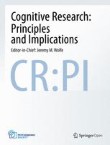Cognitive Research: Principles and Implications is affiliated with The Psychonomic Society
The hazards of perception: evaluating a change blindness demonstration within a real-world driver education course
Overconfidence in one’s driving ability can lead to risky decision-making and may therefore increase the accident risk. When educating people about the risks of their driving behavior, it is all too easy for i...
